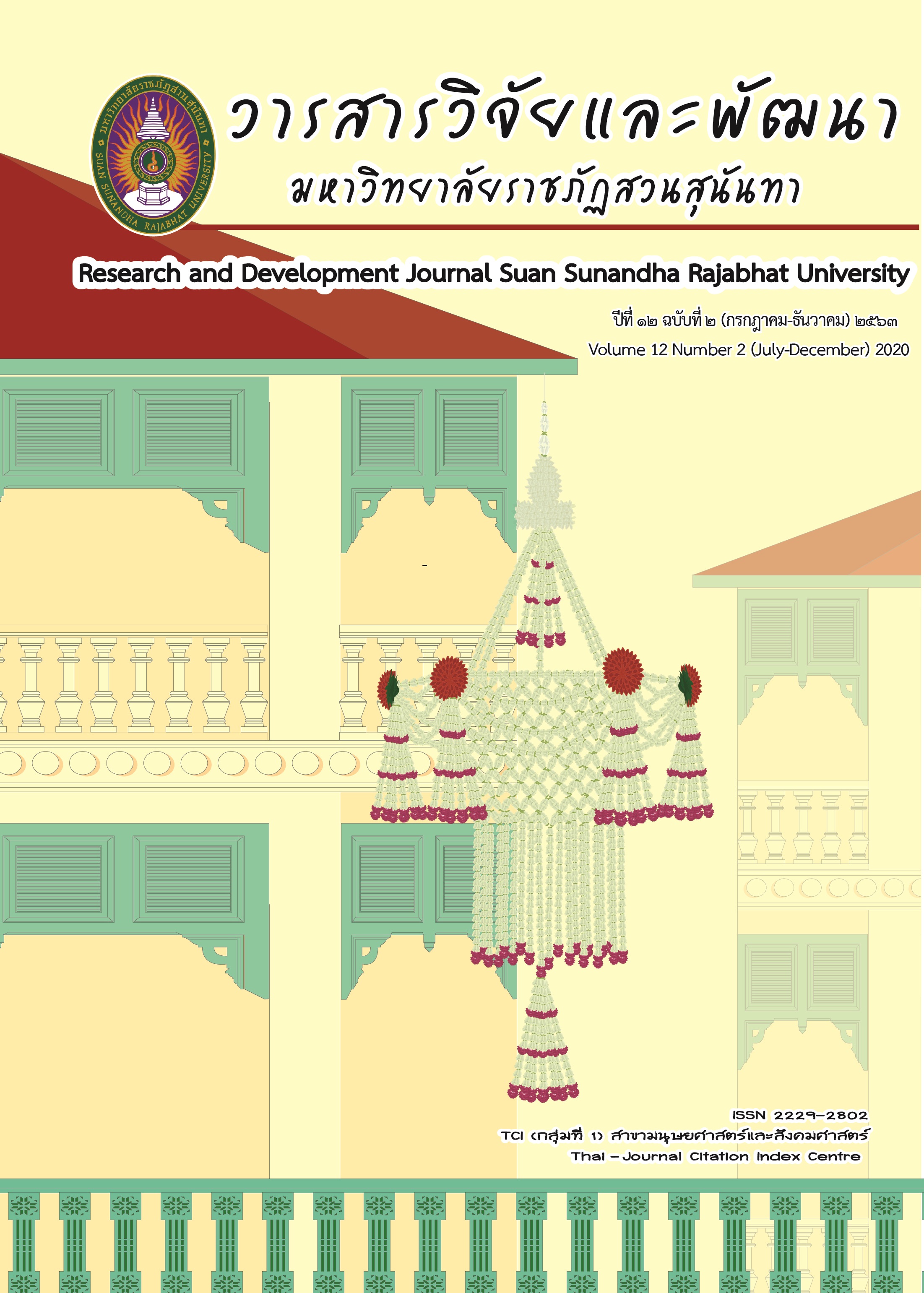กลยุทธ์ทางเลือกการสร้างความสมดุลในชีวิตและการทำงานของบุคลากร ในองค์กรที่มีสมรรถนะสูงในประเทศไทย
DOI:
https://doi.org/10.53848/irdssru.v12i2.248720คำสำคัญ:
กลยุทธ์ทางเลือก, ความสมดุลในชีวิตและการทำงาน, องค์กรที่มีสมรรถนะในประเทศไทยบทคัดย่อ
การวิจัยนี้ศึกษาองค์ประกอบเชิงสำรวจของความสมดุลในชีวิตและการทำงานของบุคลากรในองค์กรที่มีสมรรถนะสูง พร้อมกับวิเคราะห์ปัจจัยที่มีผลต่อความสมดุลในชีวิตและการทำงานของบุคลากรและเพื่อนำไปใช้ในการกำหนดกลยุทธ์ทางเลือกการสร้างความสมดุลในชีวิตและการทำงานของบุคลากรในองค์กรที่มีสมรรถนะสูงในประเทศไทย มีขั้นตอนการวิจัย 3 ขั้นตอน คือ ศึกษาองค์ประกอบของความสมดุลในชีวิตและการทำงานของกลุ่มตัวอย่าง โดยใช้สถิติการวิเคราะห์องค์ประกอบเชิงสำรวจ จากกลุ่มตัวอย่าง จำนวน 600 คน ต่อมาวิเคราะห์ปัจจัยที่มีผลต่อความสมดุลในชีวิตและการทำงานของบุคลากร โดยสมการถดถอยชนิดตัวแปรหลายตัวและการวิเคราะห์ความแปรปรวนทางเดียว จากกลุ่มตัวอย่าง จำนวน 364 คน และกำหนดกลยุทธ์ทางเลือกการสร้างความสมดุลในชีวิตและการทำงานของบุคลากรโดยการสนทนากลุ่มผู้ทรงคุณวุฒิ จำนวน 9 คน พบว่า องค์ประกอบเชิงสำรวจของความสมดุลในชีวิตและการทำงาน มี 5 องค์ประกอบ ได้แก่ (1) สภาพแวดล้อมในการทำงาน (2) องค์กรแห่งความสุข (3) การพัฒนาความรู้ความสามารถในการปฏิบัติงาน (4) ประสิทธิภาพของการทำงานเป็นทีม และ (5) การบริหารจัดการเวลา ขณะที่ปัจจัยที่มีผลต่อความสมดุลในชีวิตและการทำงานคือการสนับสนุนทางสังคมที่มีผลต่อความสมดุลในชีวิตและการทำงานของบุคลากรอย่างมีนัยสำคัญทางสถิติที่ระดับ .05 นอกจากนี้ยังพบอีกว่าอายุต่างกันมีผลต่อความสมดุลในชีวิตและการทำงานแตกต่างกันอย่างมีนัยสำคัญทางสถิติที่ระดับ .05 โดยมีกลยุทธ์ทางเลือกของการสร้างความสมดุลในชีวิตและการทำงาน พบว่า กลุ่มอายุ 50 ปีขึ้นไป ได้แก่ กลยุทธ์ “งานประสานเที่ยว” กลยุทธ์ “เรื่องเล่าจากพี่สู่น้อง” กลุ่มอายุ ระหว่าง 40-49 ปี ได้แก่ กลยุทธ์ “เราเลือกได้” ลยุทธ์ “เสาเข็มชีวิต” กลุ่มอายุ ระหว่าง 30-39 ปี ได้แก่ กลยุทธ์ “วันแห่งความสุข” กลยุทธ์ “พลังมดสร้างเมือง” และกลุ่มอายุน้อยกว่า 30 ปี ได้แก่ กลยุทธ์ “เรียนเล่นเน้นความสุข” กลยุทธ์ “เวลาคุณค่า”
เอกสารอ้างอิง
Allen, T. D., Herst, D. E. L., Bruck, C. S., & Sutton, M. (2000). Consequences associated with work-to-family conflict: A review and agenda for future research. Journal of Occupational Health Psychology, 5, 278-308.
Au, W. C., & Ahmed, P. K. (2016). Relationships between superior support, work role stressors and work-life experience. Personnel Review, 45(4), 782-803.
Auer, J., & Elton, J. (2010). Work, life and health study. Adelaide, Australia: University of South Australia.
Bardoel, E. A. (2003). The provision of formal and informal work-family practices: The relative importance of institutional and resource dependent explanations versus managerial explanations. Women in Management Review, 18(1/2), 7-19.
Blanchard, K. H. (2007). Leading at a higher level: Blanchard on leadership and creating high performing organizations. Upper Saddle River, NJ: Pearson.
Buytendijk, F. (2006). Five key to building high performance organization. Business Performance Management, 4(1), 24-30.
Cascio, W. F. (1998). Managing human resources: Productivity, quality of work life, profits (5th ed., International ed.). Boston: Irwin McGraw-Hill.
Collins, J. C. (2005). Good to great. New York: Harper Audio.
Comrey, A. L., & Lee, H. B. (1992). A first course in factor analysis (2nd ed.). Hillsdale, NJ: L. Erlbaum Associates.
de Sivatte, I., Gordon, J. R., Rojo, P., & Olmos, R. (2015). The impact of work-life culture on organizational productivity. Personnel Review, 44(6), 883-905.
de Waal, A. A. (2007) The characteristics of a high performance organization. Business Strategy Series, 8(3), 179-185.
Edwards, J. R., & Rothbard, N. P. (2000). Mechanisms linking work and family: Clarifying the relationship between work and family constructs. Academy of Management Review, 25, 178-199.
Field, A. P., Miles, J., & Field, Z. (2012). Discovering statistics using R. Thousand Oaks, CA: Sage.
Fu, C. K., & Shaffer, M. A. (2001). The tug of work and family: Direct and indirect domain-specific determinants of work-family conflict. Personnel Review, 30(5), 502-522.
Glezer, H., & Wolcott, I. (1999). Work and family life: Reciprocal effects. Family Matters, 52, 69-75.
Greenhaus, J. H., Collins, K. M., & Shaw, J. D. (2003). The relation between work-family balance and quality of life. Journal of Vocational Behavior, 63(3), 510-531.
Herzberg, F. Mausner, B. and Synderman, B.B. (1959). The Motivation to work. New York: John Willey & Sons
Holbeche, L. (2005). The high performance organization: Creating dynamic stability and sustainable success. Boston: Butterworth-Heinemann.
Huse, E. F., & Cummings, T. G. (1985). Organization development and change (3rd ed.). St. Paul, MN: West.
Hutton, A. (2005). The case for work/life balance: Closing the gap between policy and practice. Christchurch, New Zealand: Hudson Highland Group.
Hyman, J., & Summers, J. (2004). Lacking balance?: Work-life employment practices in the modern economy. Personnel Review, 33(4), 418-429.
Jutuporn Sathiankhong. (2014). Strategy for successin the management of thaipublic sector. Doctor of Philosophy, Burapha University.
Lewin, D. (1981). Collective bargaining and the quality of work life. Organizational Dynamics, 10(2), 37-53.
Linder, J. C., & Brooks, J. D. (2004). Transforming the public sector. Outlook, 3, 74-83.
MacCallum, R. C., Browne, M. W., & Sugawara, H. M. (1996). Power analysis and determination of sample size for covariance structure modeling. Psychological Methods, 1(2), 130-149.
Maslow, A. H. (1970). Motivation and personality (2nd ed.). New York: Harper & Row.
Miller, C. A. (2009). Nursing for wellness in older adults (5th ed.). Philadelphia, PA: Wolters Kluwer Health.
National Master. (2010). Thailand Population
Pyramid for 2010. Retrieved November
28,2018, from http://www.nationalmaster.com/country/th/Age_distribution
Nattapol Leelawattana. (2012). What is strategy.
Bangkok: Business Opportunity Cente.
Newstrom, J. W., & Davis, K. (1997). Organizational behavior: Human behavior at work (10th ed.). Boston: McGraw-Hill.
Office of the Permanent Secretary for Energy. (2007). High Performance Organization. Bangkok: Author.
Pattamawan Jindarak and Saisunee Kasem. (2019). Balance between life and work with a variety of age groups. Executive Journal, 39 (1), 3-11
Pasu Decharin. (2007). Organization of cultural learning. Manager Weekend, 20(1064), p. 5.
Pettigrew, A. M., & Whipp, R. (1991). Managing change for competitive success. Cambridge, MA: B. Blackwell.
Russo, M., Shteigman, A., & Carmeli, A. (2016). Workplace and family support and work-life balance: Implications for individual psychological availability and energy at work. The Journal of Positive Psychology, 11(2), 173-188.
Sirichai Kanjanawasee, Taweewat Pitayanoo, & Derek Srisukho. (2016). Selection of suitable statistics for social science research (7th ed.). Bangkok: Chulalongkorn University Press.
Tabachnick, B. G., & Fidell, L. S. (2007). Using multivariate statistics (5th ed). Boston: Pearson.
Thailand Productivity Institute. (2018). Value-Added Productivity Indicators. Bangkok: Author.
Thompson, A. A., Jr., & Strickland, A. J., III. (1999). Strategic management: Concepts and cases (11th ed.). Boston: Irwin McGraw Hill.
Walton, R. E. (1974). Improving the quality of work life. Harvard Business Review, 15(5), 12-16.
ดาวน์โหลด
เผยแพร่แล้ว
รูปแบบการอ้างอิง
ฉบับ
ประเภทบทความ
สัญญาอนุญาต
ลิขสิทธิ์ (c) 2020 มหาวิทยาลัยราชภัฏสวนสุนันทา

อนุญาตภายใต้เงื่อนไข Creative Commons Attribution-NonCommercial-NoDerivatives 4.0 International License.
บทความที่ได้รับการตีพิมพ์เป็นลิขสิทธิ์ของ สถาบันวิจัยและพัฒนา มหาวิทยาลัยราชภัฎสวนสุนันทา
ข้อความที่ปรากฏในบทความแต่ละเรื่องในวารสารวิชาการเล่มนี้เป็นความคิดเห็นส่วนตัวของผู้เขียนแต่ละท่านไม่เกี่ยวข้องกับมหาวิทยาลัยราชภัฎสวนสุนันทา และคณาจารย์ท่านอื่นๆในมหาวิทยาลัยฯ แต่อย่างใด ความรับผิดชอบองค์ประกอบทั้งหมดของบทความแต่ละเรื่องเป็นของผู้เขียนแต่ละท่าน หากมีความผิดพลาดใดๆ ผู้เขียนแต่ละท่านจะรับผิดชอบบทความของตนเองแต่ผู้เดียว





